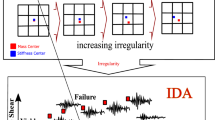Abstract
The concept of isolated structure is to separate the structure from harmful effects of earthquakes by introducing bearing. Regarding earthquakes such as the Bam and Kobe records with relatively high vertical component amplitude, it is necessary to investigate the behavior of the base-isolated structures considering vertical component of the ground motions. For this purpose, a four-story building with different eccentricities supported on elastomeric isolators with different vibration periods and damping ratios as well as three different records is used to study the effects of vertical component of earthquakes on the seismic behavior of asymmetric steel isolated structures. A rubber isolator element is used to idealize the nonlinear behavior of the isolators and a linear elastic behavior is assumed for the superstructure. The results demonstrate the significant effect of the vertical component of earthquake on the responses of structure such as axial forces, local uplift of the columns, and overturning moment of the structure and shear force of beams. For the studied cases including vertical component of earthquakes increases the compressive axial force (more than 100%) in corner columns. In addition the vertical component of earthquake causes significantly augmentation of tensile axial force and therefore, it results local uplift phenomena in isolators. Ignoring the vertical component of earthquake with high vertical amplitude will result unacceptable estimation in beam shear force and for some cases this error reaches 100%. This error is more important while the eccentricity of structure is significant (30%). Overturning safety factor is reduced when the vertical component of earthquake was included and this effect is more significant under earthquakes with higher ratio of vertical to horizontal component of earthquake.
Similar content being viewed by others
References
American Institute of Steel Construction (2005). Specification for structural steel buildings, An American National Standard.
Building Seismic Safety Council (2006). NEHRP recommended provisions for seismic regulations for new buildings and other structures, Design Examples, Part 11, FEMA 451, Washington, D.C.
Building Seismic Safety Council (2010). NEHRP recommended provisions for seismic regulations for new buildings and other structures, FEMA.
Chopra, A. K. Dynamics of Structures (2004). Theory and application to earthquake engineering, 2nd Edition, Prentice Hall, India.
Computers and Structures Inc. (1999). SAP2000 user’s manual, Berkeley, California, USA.
Dang, Y., Cheng, Huo, K., and Qin, F. (2011). “Lateral-torsional coupled seismic response of asymmetric multi-tower base isolated structures with large floors.” Advances Material Research, Vol. 243, No. 249, pp. 3975–3979.
Eisenberger, M. and Rutenberg, A. (1986).“Seismic base isolation of asymmetric shear buildings.” Engineering Structures, Vol. 8, No. 1, pp. 2–8.
Jangid, R. S. and Kelly, J. M. (2000).“Torsional displacements in baseisolated buildings.” Earthquake Spectra, Vol. 16, No. 2, pp. 443–454.
Khoshnudian, F. and Azizi, A. (2007). “Non-linear response of torsionally coupled base isolated structure.” Proc of the Institution of Civil Engineers, Structures and Buildings, Vol. 160, No. 4, pp. 207–219.
Kilar, V. and Koren, D. (2009). “Seismic behavior of asymmetric base isolated structures with various distributions of isolators.” Engineering Structures, Vol 31, Issue 4, pp. 910–921.
Lee, D. M. (1980). “Base isolation for torsion reduction in asymmetric structures under earthquake loading.” Earthquake Engineering and Structural Dynamics, Vol. 8, No. 3, pp. 349–359.
Mazza, F. and Vulcano, A. (2006).“Nonlinear response of base isolatedbuildings under near-fault ground motions.” Proc of the 13h European Conference on Earthquake Engineering and Seismology, Switzerland, p. 481.
Naeim, F. and Kelly, J. M. (1999). Design of seismic isolated structures from theory to practice, Willy, New York, USA.
Nagarajaiah, S., Reinhoorn, A. M., and Constantinou, M. C. (1989). Nonlinear dynamic analysis of three dimensional base-isolated structures (3D-BASIS), Report No. NCEER-89-0019, State University of New York, Buffalo, New York, USA.
Nagarajaiah, S., Reinhorn, A. M., and Constantinou, M. C. (1993). Computer program for nonlinear dynamic analysis of three dimensional base isolated structures (3D-BASIS), National Center for Earthquake Engineering Research, NCEER-93-0011, Buffalo, New York, USA.
Nagarajaiah, S., Reinhorn, A. M., and Constantinou, M. C. (1993). “Torsion in Base-Isolated Structures With Elastomeric Isolation Systems.” Journal of Structural Engineering ASCE, Vol. 119, No. 10, pp. 2932–2951.
Pam, T. C. and Kelly, J. M. (1983). “Seismic response of torsionally coupled base isolated structures.” Earthquake Engineering and Structural Dynamics, Vol. 11, No. 6, pp. 749–770.
Park, Y. L., Wen, Y. K., and Ang, A. H. (1986). “Random vibration of hysteretic system under bi-directional ground motions.” Earthquake Engineering and Structural Dynamics, Vol. 14. No. 2, pp. 34–53.
Shakib, H. and Fuladgar, A. (2003a). “Effect of vertical component of earthquake on the response of pure-friction base-isolated asymmetric buildings.” Engineering Structures, Vol. 25, No. 14, pp. 1841–1850.
Shakib, H. and Fuladgar, A. (2003b). “Response of pure-friction sliding structures to three components of earthquake excitation.” Computers and Structures, Vol. 81, No. 4, pp. 189–196.
Tena-Colunga, A. and Escamilla-Cruz, J. (2007). “Torsional amplifications in asymmetric base isolated structures.” Engineering Structures, Vol. 29, No. 2, pp. 237–247.
Tena-Colunga, A. and Zambrana-Rojas, C. (2006). “Dynamic torsional amplifications of base isolated structures with an eccentric isolation system.” Engineering Structures, Vol. 28, No. 1, pp. 72–83.
Author information
Authors and Affiliations
Corresponding author
Rights and permissions
About this article
Cite this article
Khoshnudian, F., Motamedi, D. Seismic response of asymmetric steel isolated structures considering vertical component of earthquakes. KSCE J Civ Eng 17, 1333–1347 (2013). https://doi.org/10.1007/s12205-013-0115-5
Received:
Revised:
Accepted:
Published:
Issue Date:
DOI: https://doi.org/10.1007/s12205-013-0115-5




